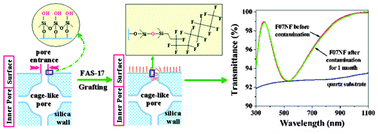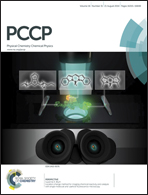Contamination-resistant silica antireflective coating with closed ordered mesopores†
Abstract
Porous silica optical antireflective (AR) coatings prepared by traditional sol–gel method have been extensively used for high power laser systems, but a serious drawback is that contamination existing in the high vacuum is easily absorbed by the disordered open pore structure, resulting in a fast decrease in transmittance. To improve the stability of transmittance in vacuum, a contamination-resistant silica AR coating with ordered mesopores completely closed by hydrophobic–oleophobic groups was successfully developed on a fused quartz substrate. The ordered mesopores in the coating were controlled under the direction of surfactant F127 via an evaporation-induced-self-assembling process and then were closed by post-grafting long chain fluoroalkylsilane. The grazing incidence small angle X-ray scattering (GISAXS) and the X-ray reflectivity (XRR) results indicated that the mesopores in the coating constructed a Fmmm orthorhombic symmetry structure with a (010) plane parallel to the substrate. Cage-like mesopores were confirmed by nitrogen adsorption–desorption analysis. The obtained coatings showed low surface roughness, excellent abrase-resistance and high transmittance of 100% on quartz substrate. Especially, the decrease of transmittance tested with polydimethylsiloxane pollution in vacuum within one-month was as small as 0.02%. The laser induced damage threshold was up to 59.8 J cm−2 at a 12 ns laser pulse of 1053 nm wavelength. This work provides an alternative way to fabricate AR coatings with high stability.


 Please wait while we load your content...
Please wait while we load your content...